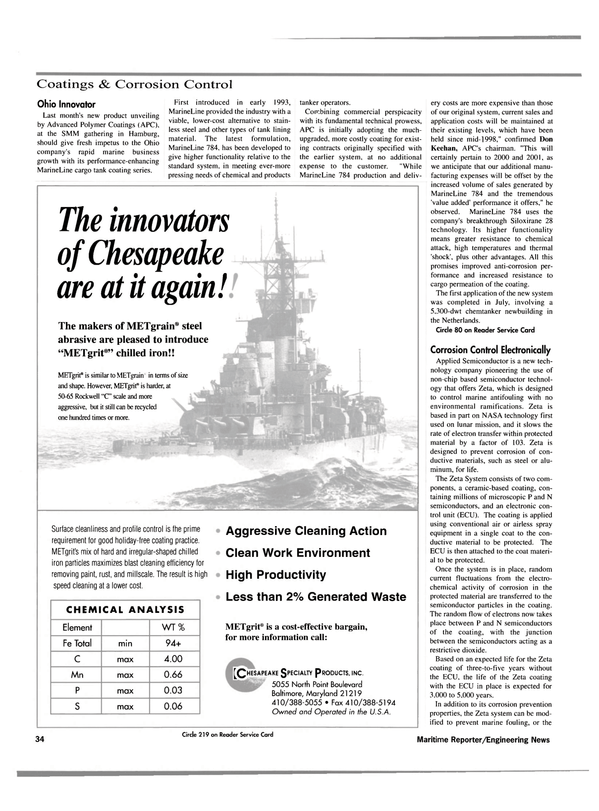
Improving Fuel Efficiency and Maintenance Time Within The Chevron Fleet
Live water systems free of sea life are one reason why the Chevron fleet runs more efficiently and economically than others. Since 1995, a number of Chevron Shipping Company's crude oil tankers have been operating smoothly with electrochlorination systems, the generators of hypochlorite that in turn prevent the fouling of live water cooling systems.
Hypochlorite is the active ingredient required for bio-fouling control. Produced in situ by the cell assemblies of the electrochlorination unit, the system eliminates microbiological organisms and macroinvertibrates without the need for back flushing or periodic cleaning.
This saves valuable time when ships are in dry dock for annual maintenance and repair.
According to W. N. Andrew, chief of Fleet Maintenance at Chevron, the units have saved an additional three to four days of ships time per year. "We have virtually eliminated main condenser cleanings," says Andrew.
Prior to installing the elctrochlorination units. Chevron counted on copper ion systems to keep biological organisms free of the main condenser. However, the ion systems offered marginal performance. With a high quality electrochlorination unit in place, main condenser performance had improved measurably.
"We are maintaining .5-in. to .75-in.
better vacuum as an average over a year due to the Chloropac anti-fouling action," notes Andrew. The upgraded vacuum not only improves the flow of cooling water to the heat exchange surfaces, it provides for an ample supply of oxygen throughout the piping systems.
Thorough oxygen diffusion helps to minimize localized corrosion as well as turbulence at inlets.
There are in fact a number of hidden costs that may be avoided with electrochlorination.
For example, the amount of fuel saved can be substantial.
Chevron, a company that knows the value of petroleum, had installed electrochlorination units on a number of its tankers to run as economically and fuel efficiently as possible. In calculating the fuel savings with electrochlorination, Andrew stated that there is approximately a two to three ton-per-day savings for each vessel.
The fuel savings and the savings in maintenance and repair help to pay off one electrochlorination system in six months to a year. This was in fact the case at Chevron, where Andrews stated "the units have met our expectation for performance improvement and cost reduction, validating our estimated project payback time of less than one year." According to USFilter's Electrocatalytic Products, a designer and manufacturer of Chloropac® electrochlorination systems, the cost of maintaining the units is minimal. "The cell assembly is designed for high velocity so that the cell may be flushed while in operation, notes Louis Lombardo of USFilter's Electrocatalytic Products. "This prevents calcareous deposits within the cell assembly and serves to protect the coated cells for approximately five to seven years." According to Lombardo, the Chloropac unit operates efficiently in a wide range of seawater temperatures.
"The unit is designed to continue operating in seawater below 14 degrees C, the point at which other systems shut down.
Ships remain protected throughout the world's oceans," Mr. Lombardo concluded.
Designed for the needs of large and small vessels, the Chloropac system is typically installed in machinery spaces near seachests, avoiding long pipe runs, while the air-cooled controller/ power supply is conveniently placed near the generator flat.
The sodium hypochlorite output of the cell is directly related to the current passing through it. This allows for automatic operation and control of output. In fact, the DC cell power allows for adjustments in output between 0-100 percent.
Circle 17 on Reader Service Card
Read Improving Fuel Efficiency and Maintenance Time Within The Chevron Fleet in Pdf, Flash or Html5 edition of October 2000 Maritime Reporter
Other stories from October 2000 issue
Content
- Danish Two-Stroke Bastion page: 8
- Powering-Up the Finnish Range page: 10
- Marine Employment Resource Debuts page: 13
- From E-Biz to E-Bust: Is Online Chartering and Sale and Purchase Possible? page: 15
- MaritimeDirect Strengthens Its E-Commerce Team page: 16
- Maritime Records and Contracts: Electronically Signed, Sealed, Delivered and Maintained? page: 17
- Maritime Industry Mourns Congressman Bateman page: 24
- BP Takes Three DH Tankers From NASSCO page: 26
- New Technology on Display at Fish Expo I WorkBoat Atlantic page: 27
- South America Gets "Kit" Traelers page: 27
- SSPC Reaches Half-Century Mark page: 29
- New Hempel Coatings Meets Future Requirements page: 31
- Ohio Innovator page: 34
- Corrosion Control Electronically page: 34
- Improving Fuel Efficiency and Maintenance Time Within The Chevron Fleet page: 36
- Litton Avondale Holds Keel Laying Ceremony page: 37
- The Abandoned Shipwreck Act: Useful Tool for Historic Preservation or Paper Tiger? page: 38
- FGH Receives $52 Million Worth Of Orders page: 42
- A Helping Hand In Stralsund page: 43
- SWM Uses Automation To Speed Workflow page: 44
- ShipRepair & Conversion Is A Maritime Exclusive page: 47
- Cammell Laird, Cascade General Enter Agreement page: 48
- Millennium's Vibration Problem Not Related To Gas Turbines page: 50
- On The Waterfront With NNS' Director Of Ship Repair page: 52
- AMHS Ferry Visits Bellingham Bay Shipyard page: 53
- Toftejorg Features Cleaning Concept For Mud Tanks page: 54
- Fleetguard's Centriguard Reduces Emissions page: 54
- Near Miss Caused By Deficient Air Pipes page: 57
- After 25 Years, Smit International Keeps Evolving page: 58
- Atlantic Marine Keeps Docks Working page: 60
- H&W Gets Its $31M From Global Marine page: 60
- National Safety Council To Hold Workshops page: 61
- Good Luck Chartering The "Rust Bucket of the Month" page: 62
- Eyes Onboard page: 62
- Subsea Installation, Heavy Lift And Transport Vessels Show Muscle In FPSO Market page: 64
- Great Lakes' Biggest Dual-Mode ITB Begins Service page: 65
- Hike Metal Constructs Boat For Pilotage Authority page: 65
- Kvichak Delivers To Pilots Association page: 66
- Gladding-Hearn Delivers First Of Two To Charleston Pilots page: 70
- Bollinger To Construct Supply Boat For Lytal Ocean page: 71
- Latest Developments in Engine Room Simulators page: 74
- U.S. Navy Keeps Ship-Shape With Software page: 76
- OSL, Philadelphia Gear Form Alliance page: 79


